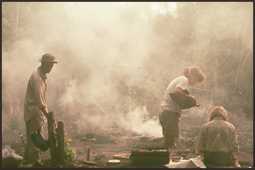|
Excavations directed by Elizabeth
Graham and David Pendergast began on Ambergris Caye, specifically
at the site of Marco Gonzalez, in 1986. The results of the preliminary
investigations have been reported in the Journal of Field
Archaeology 16:1-16. Work continued at Marco Gonzalez in
1990, and from 1991 to 1993 small-scale excavations were carried
out in the town of San Pedro, and also at Santa Cruz, on the
island's leeward side, to reveal something about the chronology
of settlement and environmental change. Graham and Pendergast's
work on the southern part of Ambergris Caye complements the archaeological
excavations carried out by Thomas Guderjan, James Garber, and
Herman Smith at sites on the northern part of the caye, and reported
in Maya Maritime Trade, Settlement, and Populations on Ambergris
Caye, Belize (edited by T. Guderjan and J. Garber, 1995,
Maya Research Program, P.O. Box 15376, San Antonio, Texas 78212).
Tom Guderjan has also written a booklet on the history of the
archaeology of Ambergris Caye, and this is available at many
bookstores and shops in Belize.
Graham and Pendergast are
presently at work on a summary of their excavations on the caye
to date. Marco Gonzalez first saw intensive use during the Protoclassic
and Early Classic periods (ca. A.D. 1-250), but scattered sherds
indicate that the area may have been utilized as early as the
Late Preclassic period (about 100 B.C.). The presence of huge
numbers of sherds from standardized vessels thought to have been
used to make salt cakes indicates that islanders focused largely
on the shipment of salt during the Late Classic period (ca. A.D.
600-800) but that this tailed off during the time of the Maya
collapse, and was replaced by renewed interest in wider-ranging
trade. Most of the 49 buildings identified at Marco Gonzalez
were either built in or modified in the Early and Middle Postclassic
periods (A.D. 900-1300). Less dense occupation continued through
the Late Postclassic and early Historic periods as indicated
by the ceramics recovered from residential remains, surface scatter,
and from offerings in a late addition to the stair of Str. 12,
a probable residential building.
Santa Cruz also seems to have
supported salt-making and distributing during the Late Classic,
and to have seen substantial expansion and construction during
the Early Postclassic. There is more evidence of Late Postclassic
residences at Santa Cruz than at Marco Gonzalez, and numerous
fruit trees indicate that the area has been used in one form
or another right down to the present day.
Excavations in San Pedro itself
turned up remains from a variety of periods as early as the Early
Classic, although it appears that Late Postclassic occupation
was the most intensive. The indications are that San Pedro was
indeed a population centre during the Late Postclassic and early
Historic periods. Historic remains cluster around the Sands Hotel,
Martha's Store, the Alijua Building, and the lots adjoining these
areas. In 1992, Pendergast discovered a number of well-preserved
burials below house floors on the Sands property, and further
remains of residential activity were discovered in 1993, although
the small areas opened made a full assessment of occupation impossible.
The stratigraphy and character of sediments on the Sands property
suggested to geologist S.J. Mazzullo from Wichita State University
that the island had, prior to the Late Postclassic period, been
crossed by a channel in the zone that is now considered the town's
centre. Further excavation is necessary before this can be confirmed,
and we are hoping to excavate portions of the last open lot in
this area, immediately behind the Alijua Building, before construction
begins on the lot in 1999.
Of the artifacts recovered,
the most complete and best preserved ceramics come from Marco
Gonzalez. A good example is the whistle figurine of a musician,
shown on our cover page. (For more on the whistle figurine, check
DISCOVERY AND MUSEUM ACTIVITIES.) The excellent preservation
of burials means that a great deal can be learned about the diet
and health of the first San Pedranos. Information on studies
being carried out by Dr. Christine White of the University of
Western Ontario and her students can be found in the RESEARCH
AND ACTIVITIES UPDATE. Sherds from Spanish Colonial olive jars
are evidence of the early Spanish contact, and bottles and ceramics
from the British and modern periods abound. Not surprisingly,
the faunal remains indicate that the island supported a lively
fishing and shellfishing industry from at least 50 B.C. onward.
Continuing environmental studies focus on the impact of Maya
occupation on soil-forming processes and vegetational succession.
Garbage and waste management studies are planned in order to
assess modern cycling of nutrients and soil-building efforts. |







